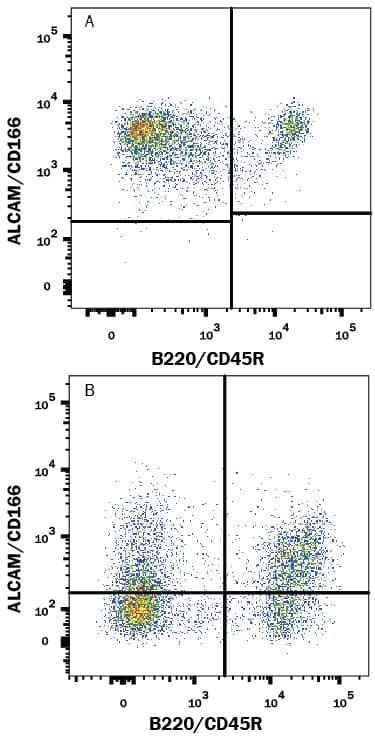Mouse ALCAM/CD166 Fluorescein-conjugated Antibody
R&D Systems, part of Bio-Techne | Catalog # FAB1172F

Key Product Details
Species Reactivity
Validated:
Cited:
Applications
Validated:
Cited:
Label
Antibody Source
Product Specifications
Immunogen
Trp28-Lys527
Accession # AAC06342
Specificity
Clonality
Host
Isotype
Scientific Data Images for Mouse ALCAM/CD166 Fluorescein-conjugated Antibody
Detection of ALCAM/CD166 in Mouse Splenocytes by Flow Cytometry.
Mouse Splenocytes either (A) activated or (B) resting were stained with Goat Anti-Mouse ALCAM/CD166 Fluorescein-conjugated Antigen Affinity-purified Polyclonal Antibody (Catalog # FAB1172F) and Rat Anti-Mouse B220/CD45R APC-conjugated Monoclonal Antibody (Catalog # FAB1217A). Quadrant markers were set based on control antibody staining (Catalog # IC108F). View our protocol for Staining Membrane-associated Proteins.Applications for Mouse ALCAM/CD166 Fluorescein-conjugated Antibody
Flow Cytometry
Sample: Mouse splenocytes
Formulation, Preparation, and Storage
Purification
Formulation
Shipping
Stability & Storage
Background: ALCAM/CD166
ALCAM, activated leukocyte cell adhesion molecule, is a type I membrane glycoprotein and a member of the immunoglobulin supergene family. It is also known as CD166, MEMD, SC-1/DM-GRASP/BEN in the chicken, and KG-CAM in the rat. ALCAM is expressed on thymic epithelial cells, activated B and T cells, and monocytes. ALCAM can bind itself homotypically and is also capable of binding CD6, NgCAM, and other, as of yet, unidentified brain proteins. ALCAM/CD6 interaction may be involved in T cell development and T cell regulation. Additionally, ALCAM/CD6 and ALCAM/NgCAM interactions may play roles in the nervous system. ALCAM has also been observed to be upregulated on highly metastasizing melanoma cell lines and may play a role in tumor migration. ALCAM is a 583 amino acid (aa) protein consisting of a 27 aa signal peptide, a 500 aa extracellular domain, a 24 aa transmembrane domain, and a 32 aa cytoplasmic domain. The extracellular domain of ALCAM contains 5 Ig-like domains of which the amino-terminal V1 domain is essential for ligand binding and ALCAM-mediated cell aggregation (1-4). The ECD of mouse ALCAM shares 97.5% aa sequence identity with rat ALCAM ECD.
References
- Bowen, M.A. et al. (1995) J. Exp. Med. 181:2213.
- Aruffo, A. et al. (1997) Immunol. Today 18:498.
- Degen, W.G. et al. (1998) Am. J. Pathol. 152:805.
- Van Kempen, L. et al. (2001) J. Biol. Chem. 276:25783.
Long Name
Alternate Names
Gene Symbol
UniProt
Additional ALCAM/CD166 Products
Product Documents for Mouse ALCAM/CD166 Fluorescein-conjugated Antibody
Product Specific Notices for Mouse ALCAM/CD166 Fluorescein-conjugated Antibody
For research use only
